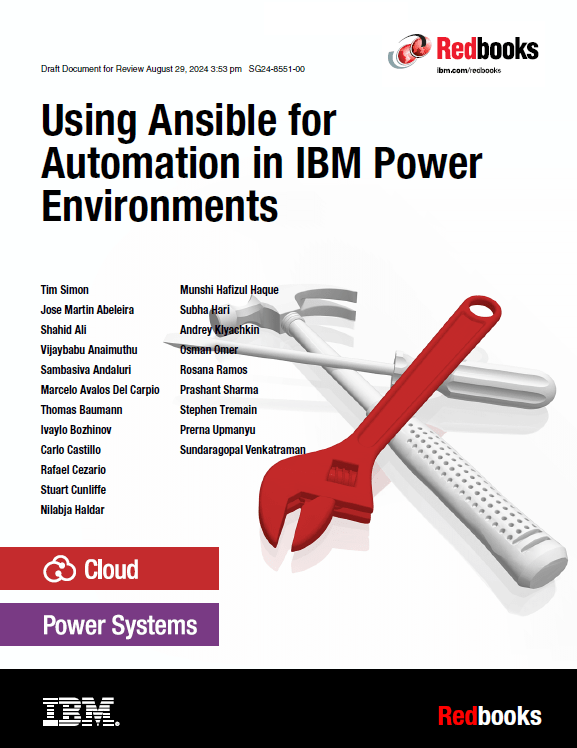In today’s fast-paced IT world, automation is no longer a luxury—it’s a necessity. IBM’s latest Redbooks publication, “Ansible in IBM Power Environments”, showcases how Ansible, a versatile and user-friendly IT automation platform, can transform how we manage IBM Power infrastructures.
Why Ansible for IBM Power?
Ansible has been gaining significant traction in the automation space, and for good reason. Its human-readable YAML syntax and agentless architecture make it an attractive option for IT professionals looking to streamline their operations. But what makes it particularly compelling for IBM Power environments?
- Comprehensive Coverage: From AIX to IBM i, Linux on Power, and OpenShift to PowerVM, Ansible can manage all aspects of your IBM Power infrastructure.
- Flexibility: Whether you’re running your automation controller on Power or another platform, Ansible has you covered.
- Integration: Ansible seamlessly integrates with existing IBM Power tools and technologies, including PowerVC and the Hardware Management Console.
Key Features and Use Cases
- Infrastructure as Code: Learn how to define and manage your IBM Power infrastructure using version-controlled code.
- Application Deployment: Automate the deployment of complex applications, from simple Node.js apps to Oracle databases and SAP environments.
- Day 2 Operations: Discover how Ansible can simplify ongoing management tasks across Linux, AIX, and IBM i environments.
- Security and Compliance: Implement and maintain security policies and compliance standards with ease.
- CI/CD Integration: Explore how Ansible fits into modern DevOps practices and continuous integration/deployment pipelines.
Getting Started
The publication provides a comprehensive guide to getting started with Ansible in IBM Power environments:
- Choosing and setting up your Ansible controller node
- Preparing your IBM Power systems as Ansible clients
- Understanding Ansible’s architecture and components
- Writing effective playbooks and leveraging roles and collections
Looking Ahead
As Ansible continues to evolve, so does its integration with IBM Power systems. The Redbooks publication offers a glimpse into future trends, including:
- The roadmap for Ansible automation in the Power ecosystem
- Ansible Automation Platform on IBM Power
- Integration with tools like Visual Studio Code and IBM watsonx Code Assistant
Conclusion
Whether you’re an Ansible novice or an experienced user looking to extend your automation to IBM Power environments, this Redbooks publication is an invaluable resource. It demonstrates how Ansible can help organizations maximize the potential of their IBM Power infrastructure, leading to increased efficiency, reduced errors, and more agile IT operations.
Ready to revolutionise your IBM Power environment with Ansible? Dive into the full Redbooks publication to start your automation journey today!
Download the Latest Version Here
Thanks and Credit
I want to give special thanks to my peers, friends, colleagues, and connections for their dedication to creating this Redbook publication. Others will benefit from the shared experience, knowledge, and wisdom.
👨🏻💻Andrey Klyachkin, Stuart Cunliffe, Osman Omer, Tim Simon, Carlo Castillo, Rafael Cezário, Jose “Martin” Abeleira Pujo, Vijaybabu Anaimuthu, Sambasiva Andaluri, Marcelo Avalos Del Carpio, Ivaylo Bozhinov, Munshi Hafizul Haque (মুন্সী হাফিজুল হক), Prashant Sharma ( प्रशांत शर्मा ), Sundaragopal Venkatraman

Leave a Reply